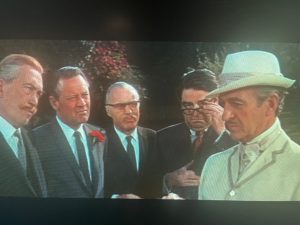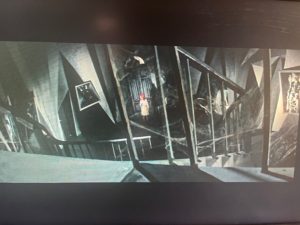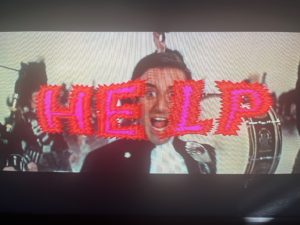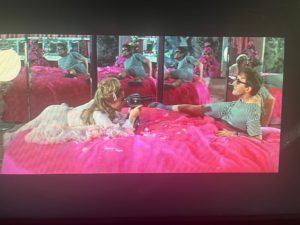
by Fiona Moore
When Albert R. Broccoli acquired the rights to the James Bond novels, the one exception was for Casino Royale, because in 1955, producer Gregory Ratoff had bought that particular story from Ian Fleming. Following Ratoff’s death in 1960, his widow sold the rights on to Charles K. Feldman of What’s New, Pussycat? fame, and he, together with Jerry Bresler, produced and released the movie this year.

Casino Royale is advertised as a “spoof” of the Bond franchise. However, having recently watched the picture courtesy of my local cinema (The Regal in Staines) I’d argue that this was a miscategorisation. It certainly has spoof elements, but it’s best seen as an example of the surreal absurdist comedy which has emerged as an entirely new subgenre in this decade.
I can’t adequately discuss this film without revealing plot details, so consider yourselves warned.
 In plot terms, Casino Royale is two almost entirely separate films, tenuously linked by a handful of scenes. The ‘first’ plot features David Niven as a retired, now celibate, British agent named James Bond, who is returned to service when all other agents are being killed off due to their fondness for sex. Bond recruits a new agent, Coop (Terence Cooper), and instigates an anti-sex training programme, thus allowing the movie to have its cake and eat it through sequences of Coop being sexually tempted but boldly resisting. Mata Bond (Bond’s daughter by Mata Hari) is recruited by her father and discovers a plot to auction SMERSH agent Le Chiffre’s collection of blackmail materials to various military forces from across the world, whose senior staff have been photographed in compromising situations.
In plot terms, Casino Royale is two almost entirely separate films, tenuously linked by a handful of scenes. The ‘first’ plot features David Niven as a retired, now celibate, British agent named James Bond, who is returned to service when all other agents are being killed off due to their fondness for sex. Bond recruits a new agent, Coop (Terence Cooper), and instigates an anti-sex training programme, thus allowing the movie to have its cake and eat it through sequences of Coop being sexually tempted but boldly resisting. Mata Bond (Bond’s daughter by Mata Hari) is recruited by her father and discovers a plot to auction SMERSH agent Le Chiffre’s collection of blackmail materials to various military forces from across the world, whose senior staff have been photographed in compromising situations.
At this point, the ‘second’ plot, starring Peter Sellers, kicks in, and it is this one which mines its source material most comprehensively. Sellers plays a professional gambler, recruited by the British government agent Vesper Lynd (Ursula Andress) to defeat Le Chiffre (Orson Welles) at baccarat at Casino Royale, using the alias James Bond. Although he succeeds in his mission, he subsequently falls into the clutches of Le Chiffre and is killed by Vesper Lynd during a surreal mind-torture sequence.
 Meanwhile Mata and Bond travel to Casino Royale, where they discover the mastermind behind SMERSH, Doctor Noah, is in fact Jimmy Bond, Bond’s nephew (Woody Allen), who has become a supervillain through feelings of inadequacy. Noah is tricked into swallowing a pill that turns him into a walking atomic bomb and a free-for-all breaks out in the casino, with invasions by cowboys, Indians, seals, the Keystone Kops, a French legionnaire, and actor George Raft — the whole thing eventually blowing sky-high as the heroes fail to prevent Noah from exploding.
Meanwhile Mata and Bond travel to Casino Royale, where they discover the mastermind behind SMERSH, Doctor Noah, is in fact Jimmy Bond, Bond’s nephew (Woody Allen), who has become a supervillain through feelings of inadequacy. Noah is tricked into swallowing a pill that turns him into a walking atomic bomb and a free-for-all breaks out in the casino, with invasions by cowboys, Indians, seals, the Keystone Kops, a French legionnaire, and actor George Raft — the whole thing eventually blowing sky-high as the heroes fail to prevent Noah from exploding.
 Certain elements of the story are indeed more or less direct spoofs, either of the James Bond franchise itself or of the wider spy series craze. The film starts with a pre-credits sequence which is just a tiny scene of Bond meeting a French agent in a pissoir, simultaneously setting up and destroying expectations of a James Bond-style pre-credits action sequence. Mata Bond’s trip to Germany places her within a stage set straight out of The Cabinet of Doctor Caligari, in a nod to the huge debt the spy film genre owes to Expressionist artform. The supporting cast includes people who’ve either appeared in Bond movies or the many independent television spy series that have cashed in on the Bond craze, notably Ursula Andress but also Vladek Sheybal and promising young character actor Burt Kwouk. As in many spy series, doubles and duplicates turn up frequently. The bizarre conceit of having all the agents, male, female, and, by the end of the adventure, animals, named James Bond/007, can be construed as a sly comment on the fact more than one actor has played Bond, or even a metatextual joke about the proliferation of code-names and numbers in such series. And, of course, the villain is motivated by a sense of personal and sexual inadequacy—what spy series villain isn’t?
Certain elements of the story are indeed more or less direct spoofs, either of the James Bond franchise itself or of the wider spy series craze. The film starts with a pre-credits sequence which is just a tiny scene of Bond meeting a French agent in a pissoir, simultaneously setting up and destroying expectations of a James Bond-style pre-credits action sequence. Mata Bond’s trip to Germany places her within a stage set straight out of The Cabinet of Doctor Caligari, in a nod to the huge debt the spy film genre owes to Expressionist artform. The supporting cast includes people who’ve either appeared in Bond movies or the many independent television spy series that have cashed in on the Bond craze, notably Ursula Andress but also Vladek Sheybal and promising young character actor Burt Kwouk. As in many spy series, doubles and duplicates turn up frequently. The bizarre conceit of having all the agents, male, female, and, by the end of the adventure, animals, named James Bond/007, can be construed as a sly comment on the fact more than one actor has played Bond, or even a metatextual joke about the proliferation of code-names and numbers in such series. And, of course, the villain is motivated by a sense of personal and sexual inadequacy—what spy series villain isn’t?
 However, both plots reach their highest, as well as their lowest, moments when they embrace the surreal comedy ethos. Arguably this started with The Goon Show, of which Sellers was a key member, before really finding its home with audiences in the Sixties. Current examples of this genre include What’s New, Pussycat?, Round The Horne, the Dadaist stylings of the Bonzo Dog Doo-Dah Band and At Last the 1948 Show. The trend is gaining strength: reportedly Paul McCartney is also a fan and is keen to adopt fantastical elements into Beatles films. So it’s not surprising, given the involvement of Sellers and Feldman, that Casino Royale would be taken in such a direction.
However, both plots reach their highest, as well as their lowest, moments when they embrace the surreal comedy ethos. Arguably this started with The Goon Show, of which Sellers was a key member, before really finding its home with audiences in the Sixties. Current examples of this genre include What’s New, Pussycat?, Round The Horne, the Dadaist stylings of the Bonzo Dog Doo-Dah Band and At Last the 1948 Show. The trend is gaining strength: reportedly Paul McCartney is also a fan and is keen to adopt fantastical elements into Beatles films. So it’s not surprising, given the involvement of Sellers and Feldman, that Casino Royale would be taken in such a direction.
 The picture’s surreal comedy doesn’t always work. For instance, there’s an annoyingly self-indulgent sequence which seems just an excuse for Sellers to dress up as historical characters. Others are better: Niven’s Bond, for instance, lives on an estate guarded by a pride of lions (“I did not come here to be devoured by symbols of monarchy!” protests the Soviet head of espionage), and the idea James Bond and Mata Hari had a relationship is a somehow appropriate melding of the archetypes of the male and female spy. Mata Bond stops the auction of Le Chiffre’s compromising photos by switching the projector to a war film: as if triggered, the British, American, Chinese and Russian representatives instantly all start fighting each other, in a comment on the Cold War worthy of Doctor Strangelove.
The picture’s surreal comedy doesn’t always work. For instance, there’s an annoyingly self-indulgent sequence which seems just an excuse for Sellers to dress up as historical characters. Others are better: Niven’s Bond, for instance, lives on an estate guarded by a pride of lions (“I did not come here to be devoured by symbols of monarchy!” protests the Soviet head of espionage), and the idea James Bond and Mata Hari had a relationship is a somehow appropriate melding of the archetypes of the male and female spy. Mata Bond stops the auction of Le Chiffre’s compromising photos by switching the projector to a war film: as if triggered, the British, American, Chinese and Russian representatives instantly all start fighting each other, in a comment on the Cold War worthy of Doctor Strangelove.
 Furthermore, the surrealist aspect transforms some of the problems and conflicts that arose during its production, from potential flaws to part of an overarching psychedelic atmosphere. Orson Welles had apparently insisted on performing magic tricks on camera, but these become both a send-up of the contrived “eccentricities” of spy-series villains and a deeper comment on illusion and artifice. The title sequence, which starts out as a simple riff on Bond films’ animated credits, becomes increasingly disconcerting, the imagery including walls of eyes staring pitilessly out at the viewer, with connotations of surveillance and voyeurism.
Furthermore, the surrealist aspect transforms some of the problems and conflicts that arose during its production, from potential flaws to part of an overarching psychedelic atmosphere. Orson Welles had apparently insisted on performing magic tricks on camera, but these become both a send-up of the contrived “eccentricities” of spy-series villains and a deeper comment on illusion and artifice. The title sequence, which starts out as a simple riff on Bond films’ animated credits, becomes increasingly disconcerting, the imagery including walls of eyes staring pitilessly out at the viewer, with connotations of surveillance and voyeurism.
 At the climax, the presence of multiple James Bonds escalates into a scenario where literally everyone becomes the titular hero; and this, together with the recurrence of doubles and duplicates, poses serious questions about how we construct our identity in modern society. At the end, everyone dies, going to Heaven or Hell, the accompanying random images and cheery music underscoring that there can be no guaranteed rescue or happy-ever-after in the atomic age.
At the climax, the presence of multiple James Bonds escalates into a scenario where literally everyone becomes the titular hero; and this, together with the recurrence of doubles and duplicates, poses serious questions about how we construct our identity in modern society. At the end, everyone dies, going to Heaven or Hell, the accompanying random images and cheery music underscoring that there can be no guaranteed rescue or happy-ever-after in the atomic age.
Perhaps the ethos of the movie is best summarised by Bacharach’s blockbusting theme song, which becomes more and more like a giddy stream-of-consciousness riff on spy picture clichés as it goes along (“The formula is safe with old 007, he’s got a redhead in his arms… they’ve got us on the run, with guns and knives, we’re fighting for our lives… have no fear, Bond is here!”). The viewer is led to acknowledge the vapidity of spy film clichés, but also to see them transmuted into something that’s less easy to define. Guided by the familiar phrases, one is tempted to search for meaning, but at the end of it, the meaning is simply what the viewer wants to make of it. Three and a half stars.

![[August 4, 1967] Bond Movie. James Bond Movie (<i>Casino Royale</i>)](https://galacticjourney.org/wp-content/uploads/2022/08/670427casinoroyale-672x372.jpg)
